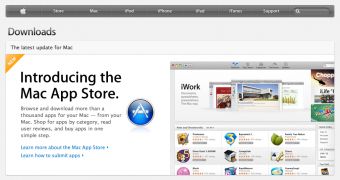Without warning, but with good reason, Apple has officially erased the Mac OS X Downloads section from its website after leaving it unattended for more than half a year.
The reason for its removal is fairly obvious: the Mac App Store.
After launching the new digital storefront for first- and third-party Mac apps in early January, Apple slowly stopped maintaining the Downloads area (located at http://www.apple.com/downloads) dedicated to third-party Mac software.
Accessing it now takes you to a page that advertises the Mac App Store.
That section is not to be mistaken with Apple’s Support Downloads area (located at http://support.apple.com/downloads), which still offers up important system and application updates for Apple customers.
Introduced with Mac OS X 10.6.6, the sixth maintenance and security update to Snow Leopard, the Mac App Store has become the primary method touted by Apple for downloading and installing new software on a Mac.
Many customers, however, still rely on popular download platforms like Softpedia to easily obtain the software they need.
For example, our site offers a function called ‘Download Hubs’ which allows visitors to punch in key words related to the functionality they seek.
Our smart algorithms then churn up those search terms and offer one, or several titles that fit the bill. The Mac App Store currently can’t do that.
Still, there was no reason whatsoever for Apple to keep the web-based OS X Downloads area alive.
While the Mac App Store does enforce new rules for developers - which is why some prefer to stick to the old-fashioned way of distributing their software - the tool is at home on Mac OS X.
A strong indication of that is Apple making OS X Lion available exclusively through the Mac App Store.
The company requires everyone who uses the digital venue to have an Apple ID in order to download and install software through its interface.

 14 DAY TRIAL //
14 DAY TRIAL //